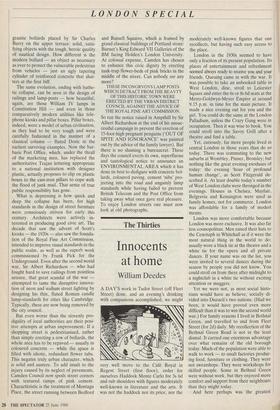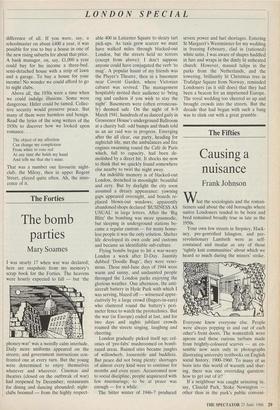The Thirties
Innocents at home
William Deedes
A DAY'S work in Tudor Street (off Fleet Street) done, and an evening's drinking with companions accomplished, we might very well move to the Café Royal in Regent Street (first floor), order for ourselves Haddock Monte Carlo for 3s 6d and rub shoulders with figures moderately well-known in literature and the arts. It was not the haddock nor its price, nor the moderately well-known figures that one recollects, but having such easy access to the place.
London in the 1930s seemed to have only a fraction of its present population. Its places of entertainment and refreshment seemed always ready to receive you and your friends. Queuing came in with the war. It was possible to take an unbooked table in West London, dine, stroll to Leicester Square and enter the 6s or 8s 6d seats at the Metro-Goldwyn-Meyer Empire at around 9.15 p.m. in time for the main picture. It made a nice evening out for you and the girl. You could do the same at the London Palladium, unless the Crazy Gang were in occupation. Then it was wise to book. You could stroll into the Savoy Grill after a theatre and find a table.
Yet, curiously, far more people lived in central London in those years than do so today. There was commuting to the new suburbs at Wembley, Pinner, Bromley; but nothing like the great evening exoduses of today: the evening 'hour of profound human change', as Scott Fitzgerald de- scribed it. At least double today's number of West London clubs were thronged in the evenings. Houses in Chelsea, Mayfair, Belgravia and Kensington were used as family homes, not for commerce. London was affordable for a family of modest means.
London was more comfortable because London was more exclusive. It was also far less cosmopolitan. Men raised their hats to the Cenotaph in Whitehall as if it were the most natural thing in the world to do; usually wore a black tie at the theatre and a white tie for the opera and all private dances. If your name was on the list, you were invited to several dances during the season by people you did not know. You could stroll on from there after midnight to a nightclub in a white tie without exciting attention or muggers.
Yet we were not, as most social histo- rians would have us believe, socially di- vided into Disraeli's two nations. (Had we been, it would have proved even more difficult than it was to win the second world war.) For family reasons I lived in Bethnal Green, and travelled to and from Fleet Street (for 2d) daily. My recollection of the Bethnal Green Road is not in the least dismal. It carried one enormous advantage over what remains of the old borough today. Much of the population were able to walk to work — to small factories produc- ing food, furniture or clothing. They were not sweatshops. They were workshops for skilled people. Some in Bethnal Green were without work, but they enjoyed more comfort and support from their neighbours than they might today.
And here perhaps was the greatest
LONDON SPECIAL
difference of all. If you were, say, a schoolmaster on about £400 a year, it was possible for you to buy a house in one of the new rising suburbs for about that price. A bank manager, on, say, £1,000 a year could buy for his income a three-bed, semi-detached house with a strip of lawn and a garage. To buy a house for your income! No wonder we could afford to go to night clubs.
Above all, the 1930s were a time when we could indulge illusions. Some were dangerous: Hitler could be tamed. Collec- tive security would preserve peace. But many of them were harmless and benign. Read the lyrics of the song writers of the 1930s to discover how we looked upon romance.. .
The object of my affection Can change my complexion From white to rose red At any time she holds my hand And tells me that she's mine.
That was a number our favourite night- club, the Milray, then in upper Regent Street, played quite often. Ah, the inno- cence of it.











































































 Previous page
Previous page